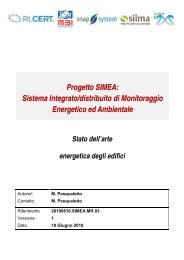Stato dell'arte energetica degli edifici - Automatica - Università degli ...
Stato dell'arte energetica degli edifici - Automatica - Università degli ...
Stato dell'arte energetica degli edifici - Automatica - Università degli ...
Create successful ePaper yourself
Turn your PDF publications into a flip-book with our unique Google optimized e-Paper software.
SIMEA <strong>Stato</strong> dell’arte <strong>energetica</strong> <strong>degli</strong> <strong>edifici</strong><br />
1.2.28. ESP-r<br />
55<br />
Doc.No 20100610.SIMEA.MR.03<br />
Versione 1<br />
General purpose simulation environment which supports an indepth<br />
appraisal of the factors which influence the energy and<br />
environmental performance of buildings. The ESP-r system has been<br />
the subject of sustained developments since 1974 and in 2002<br />
converted to the GNU Public License.<br />
ESP-r has the objective of simulating building performance in a<br />
manner that: a) is realistic and adheres closely to actual physical<br />
systems, b) supports early-through-detailed design stage appraisals,<br />
and c) enables integrated performance assessments in which no single<br />
issue is unduly prominent.<br />
ESP-r attempts to simulate the real world as rigorously as<br />
possible and to a level which is consistent with current best practice in<br />
the international simulation community.<br />
By addressing all aspects simultaneously, ESP-r allows the designer to explore the complex<br />
relationships between a building's form, fabric, air flow, plant and control. ESP-r is based on a finite volume,<br />
conservation approach in which a problem (specified in terms of geometry, construction, operation, leakage<br />
distribution, etc.) is transformed into a set of conservation equations (for energy, mass, momentum, etc.)<br />
which are then integrated at successive time-steps in response to climate, occupant and control system<br />
influences. ESP-r comprises a central Project Manager around which are arranged support databases, a<br />
simulator, various performance assessment tools and a variety of third party applications for CAD,<br />
visualization and report generation.<br />
In keeping with the philosophy of linking ESP-r to other modelling systems, users can now export to<br />
EnergyPlus an ESP-r model with materials, constructions, surfaces (all three and four sided surfaces as well<br />
as those including one window or one door - more complex surfaces are omitted). Boundary condition<br />
attributes are translated and the parent/child relationship between opaque and transparent surfaces<br />
established. The exported models usually pass the EnergyPlus parser with no errors or with minor warnings.<br />
Currently, approximate optical properties are established and schedules are not yet included.<br />
1.2.28.1. Validation/Testing<br />
ESP-r has been extensively validated. See Strachan P A. 2000. 'ESP-r: Summary of Validation<br />
Studies', ESRU Technical Report, University of Strathclyde, Glasgow. for more information.<br />
1.2.28.2. Expertise Required<br />
Understanding of thermo-physical processes in buildings, environmental systems and controls.<br />
1.2.28.3. Users<br />
Hundreds of users, primarily in Europe and Asia.<br />
1.2.28.4. Audience<br />
Engineers, researchers, architects, energy consultants.<br />
1.2.28.5. Input<br />
Building geometry can be defined either using CAD tools or in-built facilities. ESP-r is compatible<br />
with the AutoCAD and ECOTECT which can be used to create a building representation of arbitrary<br />
complexity. Models can be exported to other assessments tools such as TSBI3 and Radiance. Constructional
















